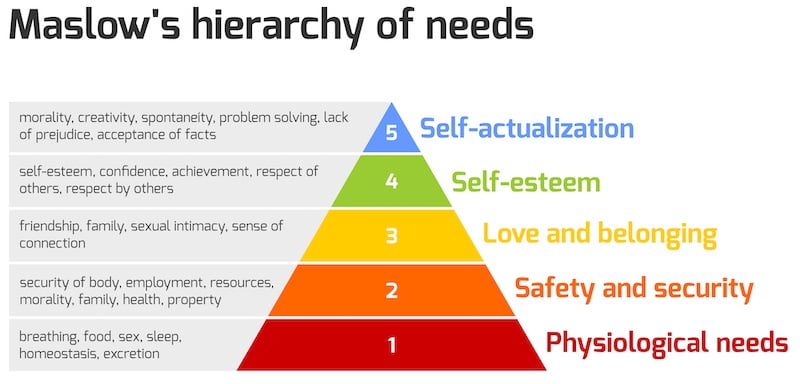Selling anything, including zero homes, is about linking a customer’s needs with a product’s benefits. There is an art to finding new and rewarding methods for making these links. An old concept from psychology can still be useful today.
The psychologist, Abraham Maslow, outlined a hierarchy of human needs, starting with basics such as physiological and safety needs. When those needs have been fulfilled people strive to fulfill higher needs, such as their needs for belonging and self-esteem. And when those needs are met they have the capacity to fulfill their moral and problem-solving needs including caring for others and community.

How does this simplified hierarchy of human needs relate to selling homes? It serves as a roadmap for creating effective sales messages for virtually all buyers. At the most basic levels of need, we all want to feel that our shelter is safe and healthy and supports us in being financially secure. At higher levels,we want our homes to build our self-esteem while garnering acceptance and respect from others. When these needs are met, humans seek higher levels, which involve caring for others, and the planet and solving common problems, such as climate change. Every buyer has needs that exist at one or more of these levels. Because zero homes fulfill needs at every level, an effective salesperson should link a customer’s current level of need with the relevant benefits of zero by crafting an appropriate, individualized message.
Zero Fulfills Basic Needs
Zero homes fulfill basic needs much better than standard homes by providing better protection from temperature extremes. They are quieter, more comfortable, free of drafts, and more durable.
They provide fresh, healthy, filtered air — protecting residents from allergies and asthma, as well as diluting and expelling viruses and bacteria. The fresh-air system in an airtight home provides resilience against indoor and outdoor air pollution.
There is growing consumer awareness of home health threats along with increased awareness of the benefits of living in healthier homes. With the ongoing COVID-19 pandemic, people are developing a new relationship to their homes. As they spend more time there, they want comfort and air quality to be high and energy bills low.
Zero homes, with their freedom from energy costs, provide economic security: There will be no energy bill increases in the future. Greater financial security translates into a lower loan default rate. Zero homes have reduced maintenance because they are better built. And most zero energy builders become partners with the homebuyer — partners who are there if there are any home warranty challenges.
Buyers operating at the level of basic needs, place a high priority on affordability, low cost of ownership, and health, which together becomes the primary sales message for those at the base of the pyramid. With proper financing, buyers on the margin for mortgage eligibility can use lower monthly costs as buying power to qualify for a larger mortgage.
Zero Fulfills Higher Needs
Further up in Maslow’s hierarchy of needs are belonging and self-esteem. Here a buyer’s attention can turn to neighborhood, home size, floor plan, appearance, and amenities — factors that can fulfill these needs. Traditional home marketing uses this motivation with its focus on superficial design features and sizzle. A zero home can have all the design features and amenities — the sizzle — that sell any new home. The many benefits of zero energy homes push them ahead of conventional houses and can help close the sale.
People who choose zero homes increasingly feel greater self-esteem and acceptance as zero homes become the “must have” for new homebuyers. While zero homes are much more than a fad, everyone in the industry should work together to create a new powerful consumer trend to make them the “next big thing.” Zero energy homes represent positive change in a society that values progress. As zero energy homes evolve into the new standard for what is “high-quality”, sellers can use the human need for acceptance to good advantage. For some buyers this can be a strong motivator.
When considering buyer self-esteem, builders, and sellers need to keep home operation simple. Too much complexity can make some people feel less secure and potentially threaten their self-esteem. The good news: zero homes are so energy efficient, there’s no need for high-tech controls to slash energy costs and provide the many other values zero has to offer. Simplicity can be more satisfying and rewarding than sophistication.
At this level, the sales message focuses on a buyer’s self-image. Salespeople might say, “You can afford more amenities because the cost of ownership will be lower.” Or “You can have the home of the future today!”
Good for the Greater Community
The highest level in Maslow’s hierarchy is self-actualization, which includes acceptance of facts, problem-solving, and morality. People at this level are freed up to do what is good for others, the community, and the planet. More people are understanding the facts and challenges of climate change and the health effects of pollution, especially on the poor. They want to do something about it.
At this level of need, sellers may say: “A zero home is a wise choice for you because of your interest in living green and contributing to a sustainable planet.” Or “Many people value sustainability and this home is at the cutting edge — if you are interested in reducing your carbon footprint, this home offers the real thing — no green washing with this home.”
An Effective Sales Tool
The first step to using Maslow’s approach is to identify where the customer’s needs lie in the hierarchy. Human beings focus first on their most basic needs. Identifying these needs gives salespeople a chance to address the issues that are foremost in buyers’ minds. For those whose immediate needs have been satisfied and are able to look for more, proceed to highlighting how the home’s benefits satisfy higher level needs.
Finally, develop an effective way to communicate those benefits. This might be through a series of talking points, simple charts or graphs, a short blog, a photo series, or even a short video. These messages can be used in person, in advertising, and on websites.
Here are a few talking points for each level.
| Needs | Benefits of Zero Homes |
|---|---|
| Physiological | consistent temperature and humidity; good air quality and health |
| Safety and Security | affordability, lower monthly expenses; more comfort for self and family; greater durability; greater resilience from power outages and natural disasters |
| Love and Belonging | membership in the new sustainable society; accolades for being an early adopter; proud to own a cutting edge sustainable, high-quality home |
| Self-esteem | all the amenities of standard homes; plus solar panels, thick walls, all-electric equipment and controlled ventilation that visibly declare state-of-the-art living |
| Self-actualization | fully aware of how they have contributed to global environmental problems and are part of the solution; willing to share the benefits by building positive energy homes that address transportation, embodied carbon, and contribute to a sustainable society |
While Maslow may not have been in the sales business, his hierarchy of needs provides an effective sales model for identifying and addressing a wide variety of buyer requirements. It is especially potent for selling zero energy homes because they can fulfill the whole spectrum of buyer needs from fundamental survival to caring for future generations and the planet.
By Joe Emerson and Bruce Sullivan – inspired by CR Herro of Meritage Homes
C.R. Herro leads Meritage’s Business Innovation Program, which combines design, efficiency, sustainability, and new technologies to establish a new standard in home building that provides better comfort, healthier air, and costs less to own and operate. Many of the concepts in this blog are from two highly recommended CR Herro webinars: Selling and Marketing Green Homes and Zero Energy Homes: Better for Business, Better for Living


Hannah says:
It was interesting to read.